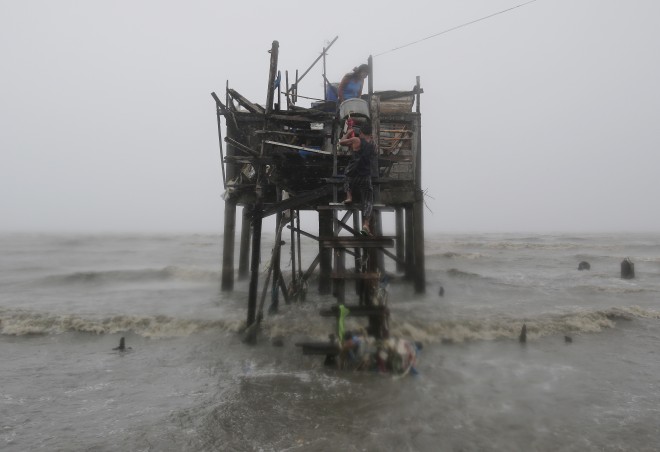
Residents carry their belongings up their house on stilts as strong winds and rains caused by Typhoon ‘Lando’ hits the coastal town of Navotas, north of Manila, Philippines on Sunday, Oct. 18, 2015. AP
TYPHOON “Lando” (international name: Koppu) maintains its strength while slowly continuing its onslaught in northern and Central Luzon.
According to the 5 p.m. weather bulletin issued by state weather bureau Pagasa, “Lando” still packs maximum sustained winds of 150 kilometers per hour (kph) and gusts of 185 kph.
As of 4 p.m., Lando is located near Santa Fe, Nueva Vizcaya.
Public storm warning Signal No. 3 is hoisted in 11 areas: Nueva Ecija, Quirino, Nueva Vizcaya, Benguet, Ifugao, Mountain Province, Kalinga, Ilocos Sur, La Union, Pangasinan, and Zambales.
Signal no. 2 is still up in Metro Manila, Bulacan, Pampanga, Tarlac, Bataan, Rizal, Northern Quezon including Polilio Islands, Cagayan including Calayan and Babuyan Islands, Isabela, Aurora, Abra, Apayao and Ilocos Norte.
Meanwhile, Signal No. 1 is raised over Batanes, Cavite, Laguna, Batangas and rest of Quezon.
Pagasa expects Lando to weaken into a severe tropical storm on October 19 and into a tropical storm on October 20. However, it is expected to leave the Philippine Area of Responsibility on Saturday.
It is moving west northwest at 5 kph.
More than 14,000 villagers have been evacuated from the typhoon’s path, including in towns prone to flash floods and landslides and coastal villages at risk from destructive storm surges, said Alexander Pama, who heads the disaster-response agency that has overseen evacuation and pre-deployment of rescue contingents.
After slamming into Casiguran town in Aurora province shortly after midnight, the typhoon weakened slightly and slowed considerably, hemmed in by the Sierra Madre mountain range and a high pressure area in the country’s north and another typhoon far out in the Pacific in the east, government forecaster Gladys Saludes said.
While weather had begun to improve in some Aurora towns, where villagers have started to clear roads of fallen trees and debris, Lando still packed a ferocity that could set off landslides and flash floods, officials said.
“It’s still typhoon intensity … there’s still danger,” Cayanan told a nationally-televised news conference. “We shouldn’t be complacent.”
2 dead in Ecija
Heavy flooding in Nueva Ecija led to the death of at least two people and forced thousands of residents to evacuate.
Nueva Ecija Governor Aurelio Umali confirmed that two persons were found dead floating in flood waters in Palayan City, the capital of the province.
The victims were not yet identified.
In an interview with the ABS-CBN News Channel, Umali also said that at least 3,251 people were evacuated.
“We expect flood waters from the mountains of Gabaldon,” Umali said.
1 dead in Metro Manila
At least one person died and six were wounded when an Earpod tree fell on a house in Quezon City due to the strong winds brought by the typhoon.
Aron Castillo, a 14-year-old boy, was sleeping inside their house in the Bureau of Forestry Development compound in Barangay Central when the tree was uprooted and hit their home at around 9 a.m. on Sunday.
A report by Radyo Inquirer said that Castillo was rushed to the East Avenue Medical Center where he died.
President Benigno Aquino III and disaster-response agencies have warned that Lando’s rain and wind may potentially bring more damage with its slow speed. But Saludes said there was less heavy rain than expected initially in some areas, including in the capital, Manila, but wind was fierce in many regions.
A wayward barge carrying coal and 10 crew drifted dangerously close to a breakwater in Manila Bay and a coast guard tugboat was deployed to tow it away, coast guard spokesman Armand Balilo said.
Forecasters said the typhoon has a cloud band of 600 kilometers (372 miles) and could dump rain over much of northern Luzon.
Appearing on nationwide television as the typhoon approached the country, Aquino appealed to the public to heed storm warnings to avoid casualties. Due to the expected massive evacuation of residents from high-risk regions, about 7.5 million people would need relief assistance, he said.
Lando is the 12th storm to hit the Philippines this year. An average of 20 storms and typhoon each year batter the archipelago, one of the world’s most disaster-prone countries.
In November 2013, Typhoon Yolanda, one of the most ferocious storms on record to hit land, barreled through the central Philippines, leveling entire towns and leaving more than 7,300 dead or missing. With a report from AP/ Anthony Esguerra
RELATED VIDEOS